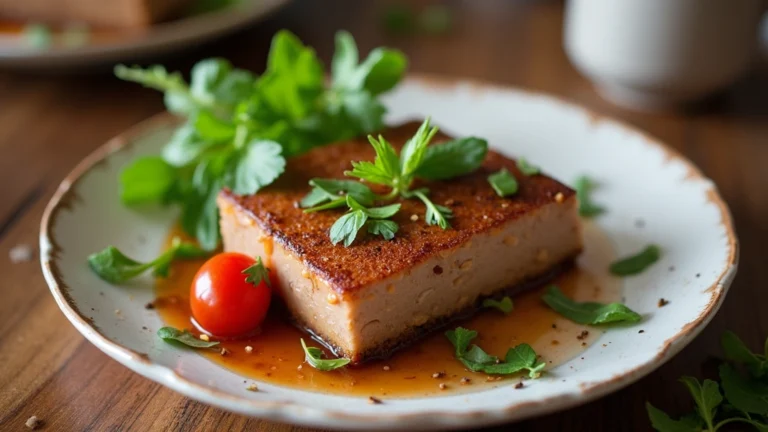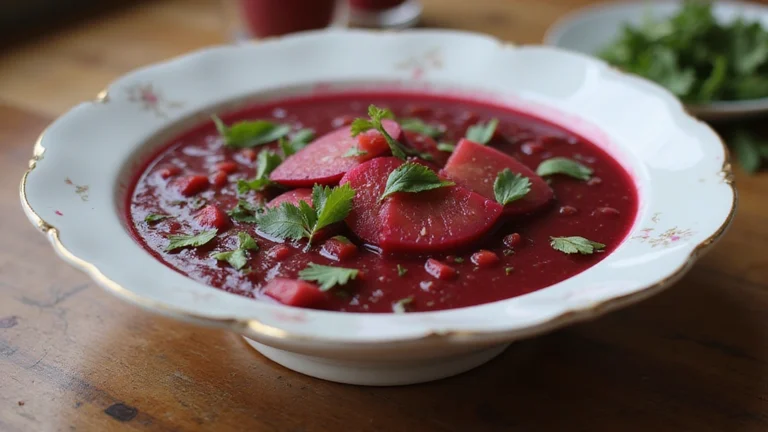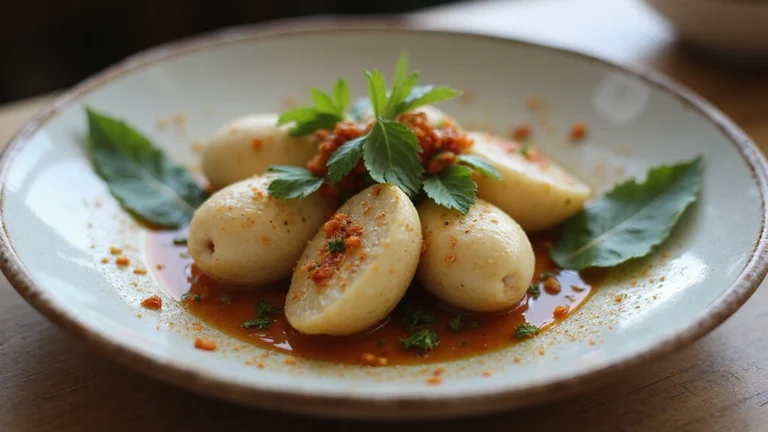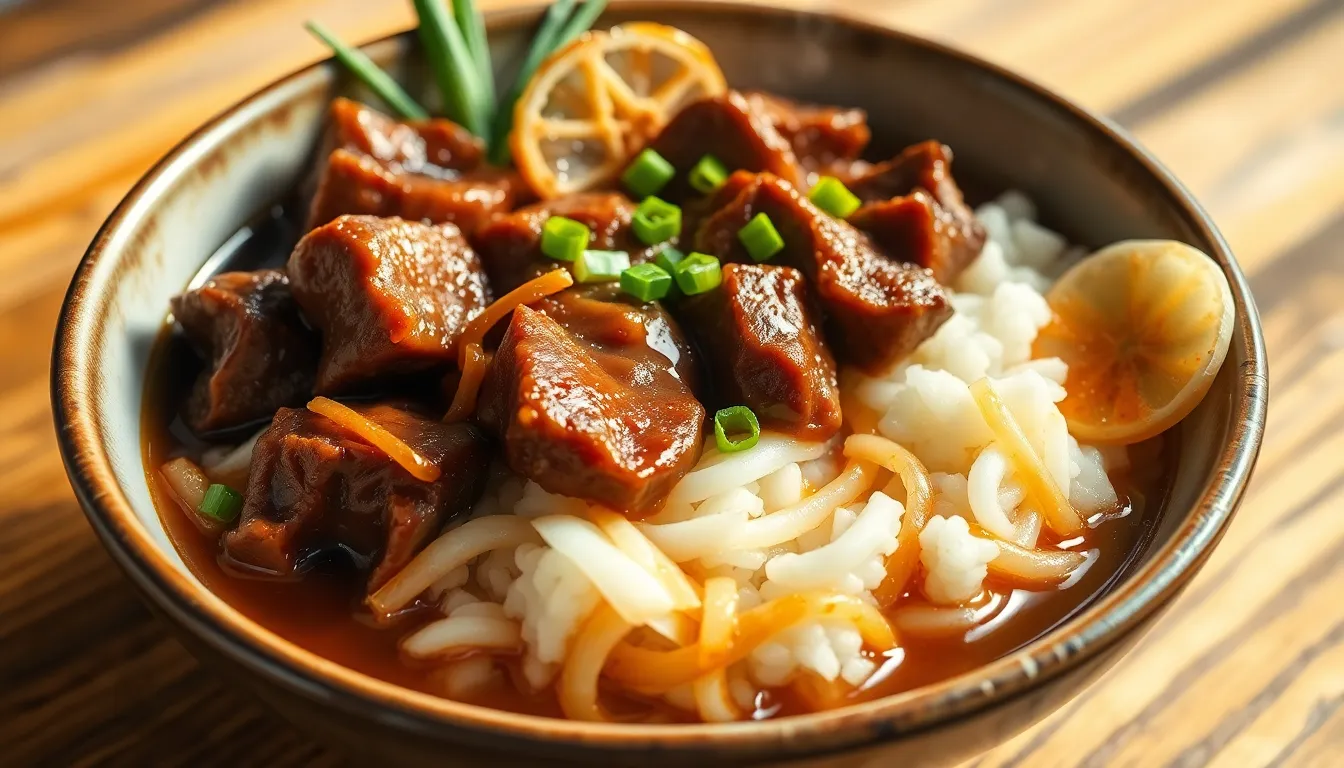
Looking for an effortless way to make authentic Japanese gyudon? This rice cooker gyudon recipe will transform your weeknight dinner routine with minimal effort and maximum flavor.
Gyudon, the beloved Japanese beef bowl, traditionally requires stovetop attention and multiple steps. But with your trusty rice cooker, you’ll create this comforting dish of thinly sliced beef and onions simmered in a sweet-savory sauce all in one pot. The rice cooks perfectly underneath while the beef mixture tenderizes above, absorbing all those umami-rich flavors.
This set-it-and-forget-it method delivers restaurant-quality gyudon without the fuss. Simply layer your ingredients, press start, and return to a complete meal that’ll have you wondering why you ever made it any other way. Perfect for busy weeknights when you crave something satisfying but don’t have time to stand over the stove.
What Is Gyudon?
Gyudon (牛丼) is a beloved Japanese dish consisting of thinly sliced beef and onions simmered in a savory-sweet sauce served over a bowl of steaming rice. The name itself tells you what you’re getting: “gyu” means beef and “don” refers to a bowl of rice topped with something. This iconic comfort food has been a staple in Japanese cuisine for generations.
The dish originated during the Meiji era (1868-1912) when beef consumption became more common in Japan. Restaurants specializing in gyudon called “gyudon-ya” can be found throughout Japan with popular chains like Yoshinoya Sukiya and Matsuya making this dish accessible to everyone.
Traditional gyudon sauce combines dashi (Japanese soup stock) soy sauce mirin (sweet rice wine) and sugar to create a perfectly balanced flavor profile that’s simultaneously savory sweet and umami-rich. The beef typically used is thinly sliced ribeye or chuck that cooks quickly while remaining tender.
What makes gyudon particularly special is its practical simplicity. The dish exemplifies the Japanese culinary philosophy of letting quality ingredients shine through straightforward cooking techniques. Even though being considered fast food in Japan gyudon delivers complex flavors and satisfying textures in every bite.
Rice cooker gyudon takes this already convenient dish and simplifies it further by combining the cooking processes of the rice and topping into a single appliance. This modern adaptation maintains the authentic flavors while reducing both active cooking time and kitchen cleanup.
Why Make Gyudon In A Rice Cooker
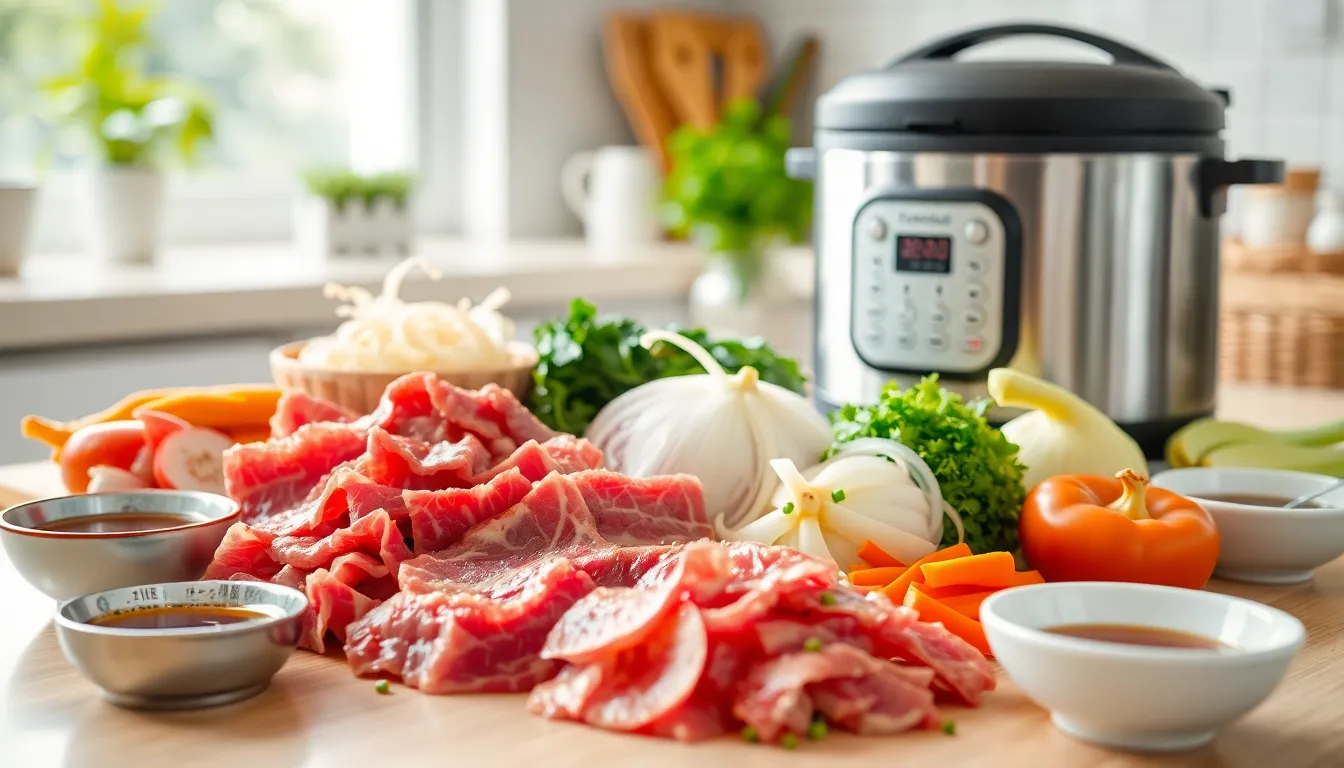
Simplicity and Convenience
You can dramatically simplify your gyudon preparation by using a rice cooker instead of the traditional stovetop method. This approach eliminates the need to cook multiple components separately as you combine beef, onions, seasonings, rice, and water all in one appliance. The rice cooker handles everything automatically, saving you valuable time in the kitchen and reducing cleanup to just one pot. Simply layer your ingredients, press start, and let the machine transform them into a complete meal.
Flavor Infusion
Your gyudon achieves deeper flavor when cooked in a rice cooker because of the strategic layering technique. Placing beef and marinade at the bottom followed by onions and then rice allows the savory-sweet sauce to permeate upward as steam rises during cooking. This process infuses every grain of rice with the harmonious blend of soy sauce, mirin, sake, and dashi flavors. The result tastes remarkably authentic even though the simplified cooking method.
Tenderness and Texture
Rice cookers create the ideal environment for achieving perfectly tender beef in your gyudon. The gentle, consistent heat and moist cooking atmosphere prevent the thinly sliced meat from becoming tough or dry. Your onions turn pleasantly soft while retaining their natural sweetness. The rice emerges with excellent texture, neither mushy nor undercooked, but properly seasoned from absorbing the flavorful cooking liquids throughout the process.
Minimal Preparation
You need only basic kitchen skills to prepare rice cooker gyudon. The preparation mainly involves slicing beef and onions plus mixing a few liquid seasonings together. No advanced techniques or constant monitoring required. The rice cooker’s automated timing system removes guesswork about when your dish is done, making this recipe particularly beginner-friendly. This foolproof method delivers consistent results even for those new to Japanese cooking.
| Benefit | Traditional Method | Rice Cooker Method |
|---|---|---|
| Active cooking time | 20-30 minutes | 5-10 minutes |
| Number of pots/pans | 2-3 | 1 |
| Monitoring needed | Constant | None |
| Risk of overcooking | Moderate | Low |
| Flavor infusion | Good | Excellent |
| Cleanup effort | Moderate | Minimal |
Equipment Needed
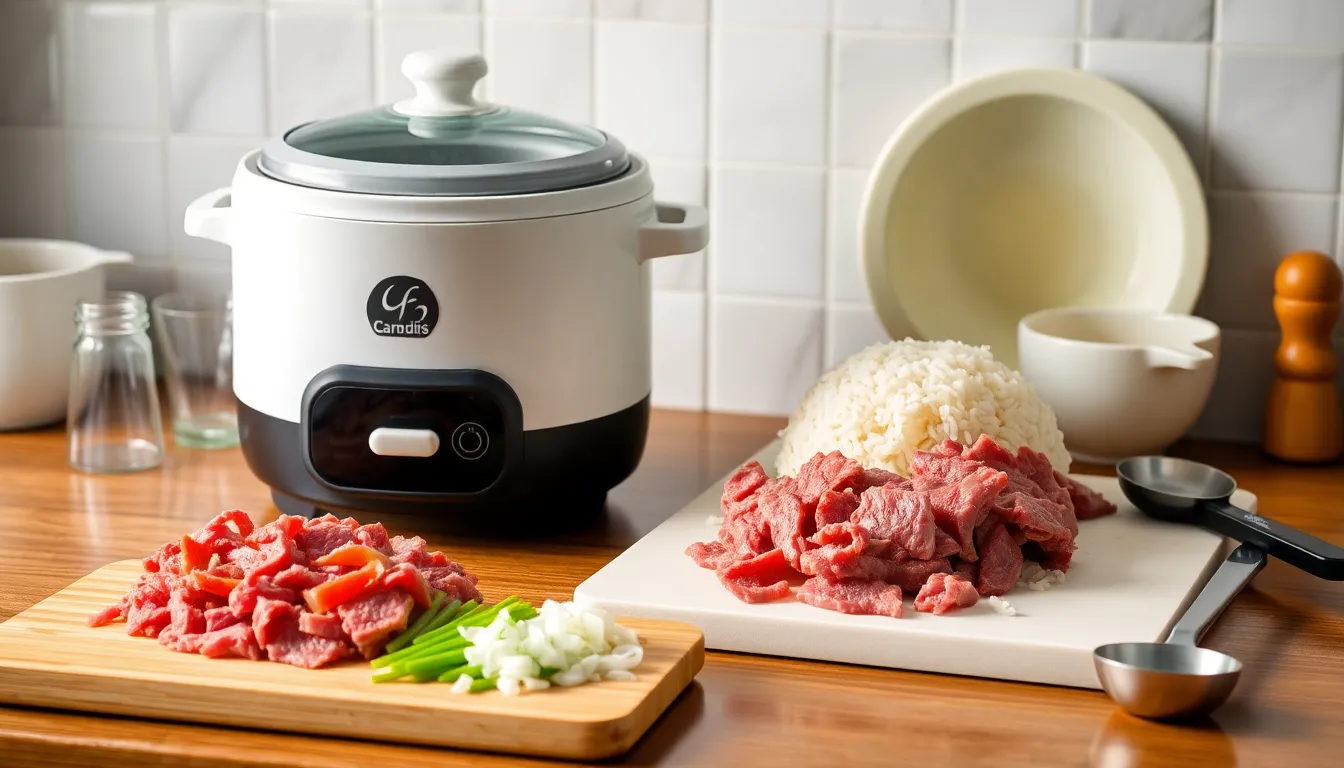
Setting up for rice cooker gyudon requires minimal equipment, making this dish perfect for small kitchens or beginners. Your primary tool will be a standard rice cooker with basic functionality.
Essential Equipment
- Rice Cooker: Any standard rice cooker with a simple on/off function works perfectly for this recipe. Models with a “white rice” setting deliver the best results.
- Measuring Cup: Use the cup that came with your rice cooker for accurate rice-to-water ratios.
- Rice Paddle or Wooden Spoon: For fluffing and serving the finished dish without scratching your rice cooker’s interior.
- Cutting Board and Knife: You’ll need these to slice your beef thinly and chop onions.
- Measuring Spoons: Essential for precise sauce ingredients measurement.
Optional Equipment Upgrades
- Tacook Dual-Cooking Plate: Some advanced rice cookers include this special insert that allows you to cook rice and beef separately but simultaneously.
- Programmable Rice Cooker: Models with delay timers let you prepare ingredients in the morning and come home to fresh gyudon.
- Rice Cooker with “Mixed” Setting: This special setting works well for recipes that combine rice with other ingredients.
Your rice cooker serves as both cooking vessel and serving dish, significantly reducing cleanup time compared to traditional stovetop gyudon methods. The equipment simplicity makes this recipe particularly accessible for college students or those with limited kitchen space.
Ingredients For Rice Cooker Gyudon
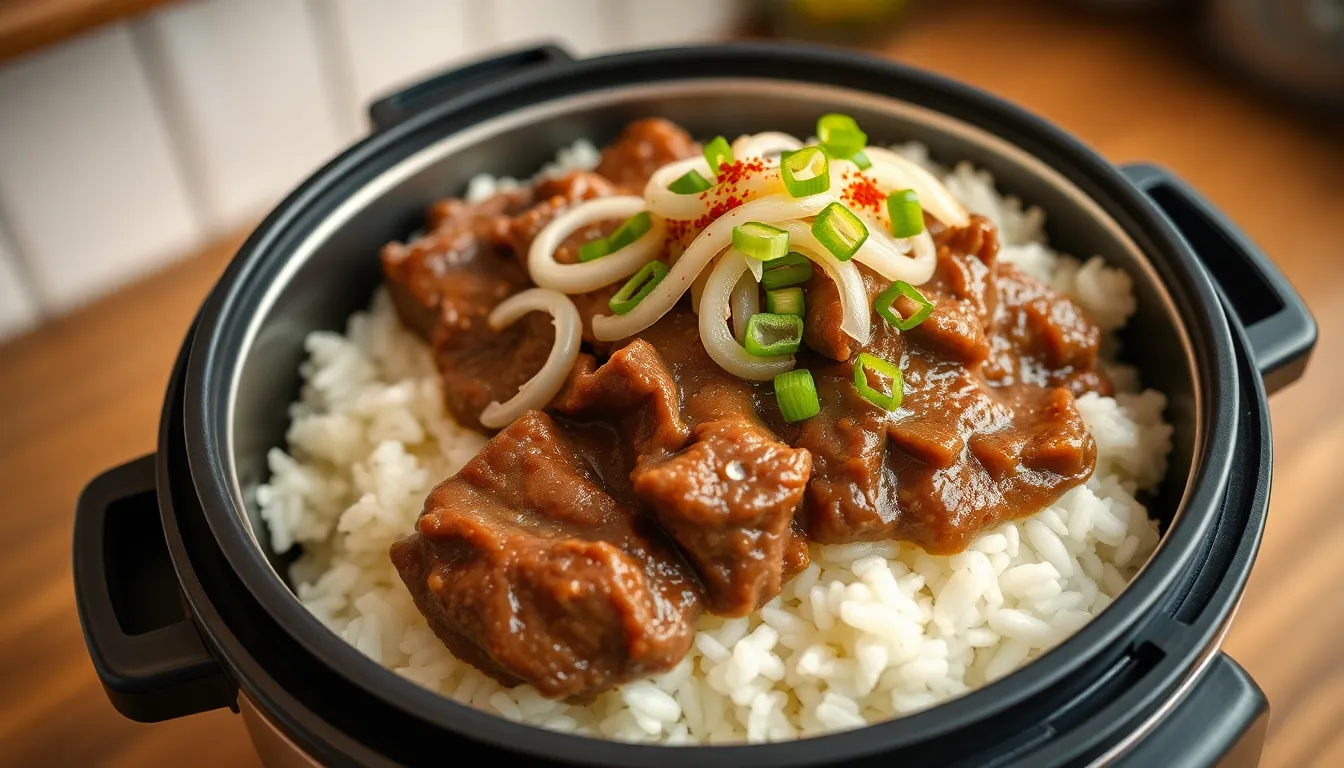
Creating authentic Japanese beef bowls at home becomes effortlessly simple when you gather these essential ingredients. The recipe separates into two main components: the perfectly cooked rice base and the flavorful beef topping that will simmer together in your rice cooker.
For The Rice
- 2 cups Japanese short-grain or pearl rice (rinsed until water runs clear)
- Water (according to your rice cooker measurements)
- Optional: 6g kombu (dried seaweed) or 3g dashi powder for enhanced umami flavor
For The Beef Topping
- 450-500g (approximately 1-1.1 lbs) thinly sliced beef (chuck or ribeye work best)
- 400g onions (2-3 medium), thinly sliced
- 15g fresh ginger, thinly sliced or grated
- 4 tbsp (60ml) soy sauce
- 2 tbsp mirin (adds sweetness and depth)
- 2 tbsp sake (helps tenderize the meat)
- 2 tsp (10g) sugar
- Dashi granules or kombu for umami depth
- 600ml water for cooking
Optional garnishes include sliced green onions, pickled ginger, shichimi togarashi (Japanese seven-spice blend), or furikake seasoning. The thinness of your beef slices matters significantly for achieving the tender texture traditional gyudon is known for. Preparing these ingredients in advance allows for seamless assembly when layering everything in your rice cooker.
How To Make Rice Cooker Gyudon
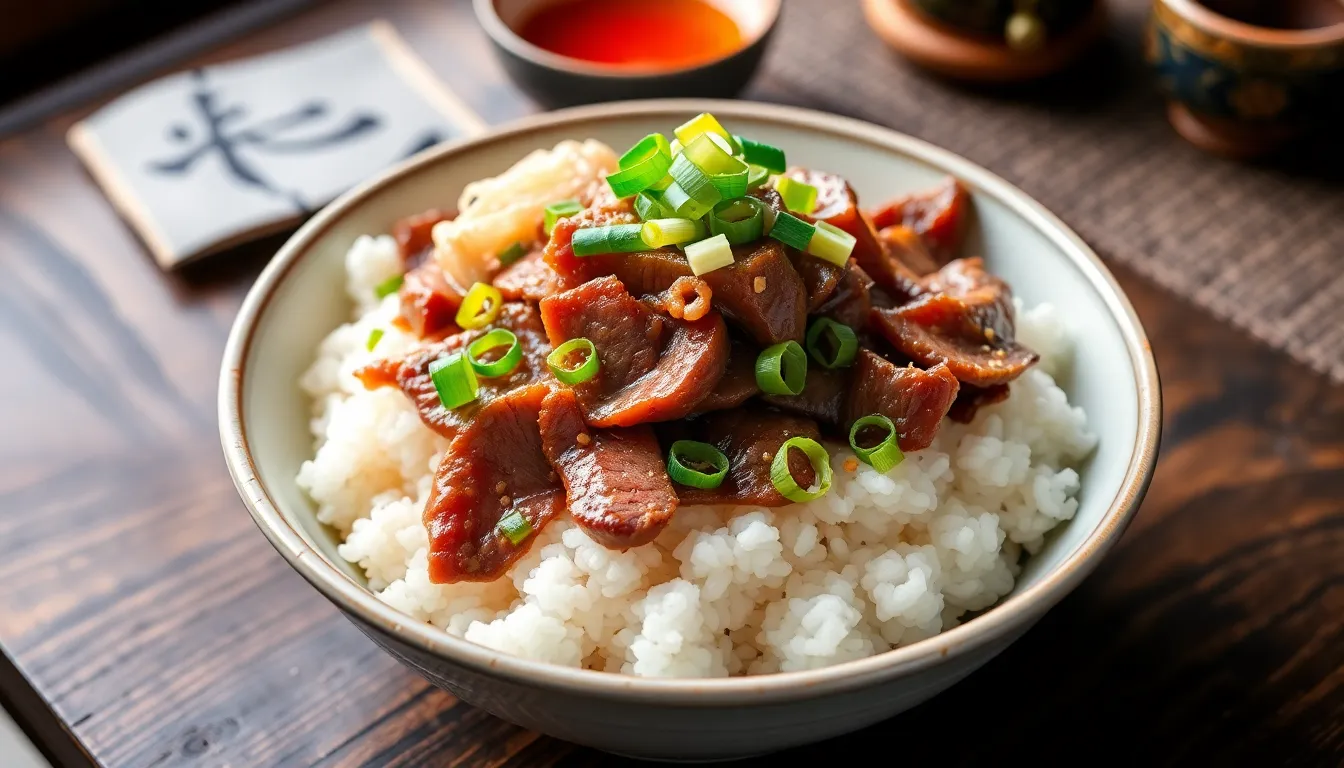
Creating this classic Japanese beef bowl in your rice cooker simplifies the entire process by allowing you to cook everything together in one pot. Follow these step-by-step instructions for a delicious meal with minimal effort and maximum flavor.
Preparing The Rice
Thoroughly rinse 2 cups of short-grain Japanese rice until the water runs mostly clear to remove excess starch. This washing process is crucial for achieving the perfect rice texture that serves as the foundation of your gyudon. After draining the rice completely, add it to your rice cooker pot and gently level it with a spoon to ensure even cooking. Select the regular cooking mode on your rice cooker for optimal results, as this setting provides the ideal temperature and timing for properly cooked Japanese rice.
Making The Beef Topping
Slice 500g (about 1.1 lb) of beef chuck or ribeye as thinly as possible to ensure tender meat in your finished dish. Cut 2-3 onions (approximately 400g) into 2cm thick slices and slice about 15g of fresh ginger very thinly to infuse aromatic flavor throughout your gyudon. Prepare the savory-sweet broth by combining 600ml water, 30ml sake, 60ml soy sauce, 10g sugar, and 6g kombu (or substitute with dashi powder or a pinch of MSG for umami depth). Place your sliced beef, onions, ginger, and the prepared broth directly into the rice cooker on top of the uncooked rice. For an alternative method, you can marinate the beef in a mixture of soy sauce, mirin, sake, dashi granules, and sugar before layering it with onions and rice in your cooker.
Assembling The Gyudon
Allow your rice cooker to complete its cooking cycle, then let everything rest for about 5 minutes before opening the lid to let the flavors settle. Gently fluff the rice with chopsticks or a rice paddle, mixing the beef and onions from the bottom to distribute all components evenly throughout the bowl. Serve your freshly made gyudon in individual bowls, adding optional traditional garnishes such as pickled ginger, shichimi togarashi (Japanese seven-spice blend), furikake seasoning, or freshly chopped green onions for enhanced flavor and presentation. Pair your rice cooker gyudon with a simple miso soup for a complete and satisfying Japanese meal that tastes like it came from a restaurant but required just a fraction of the effort.
Tips For Perfect Rice Cooker Gyudon
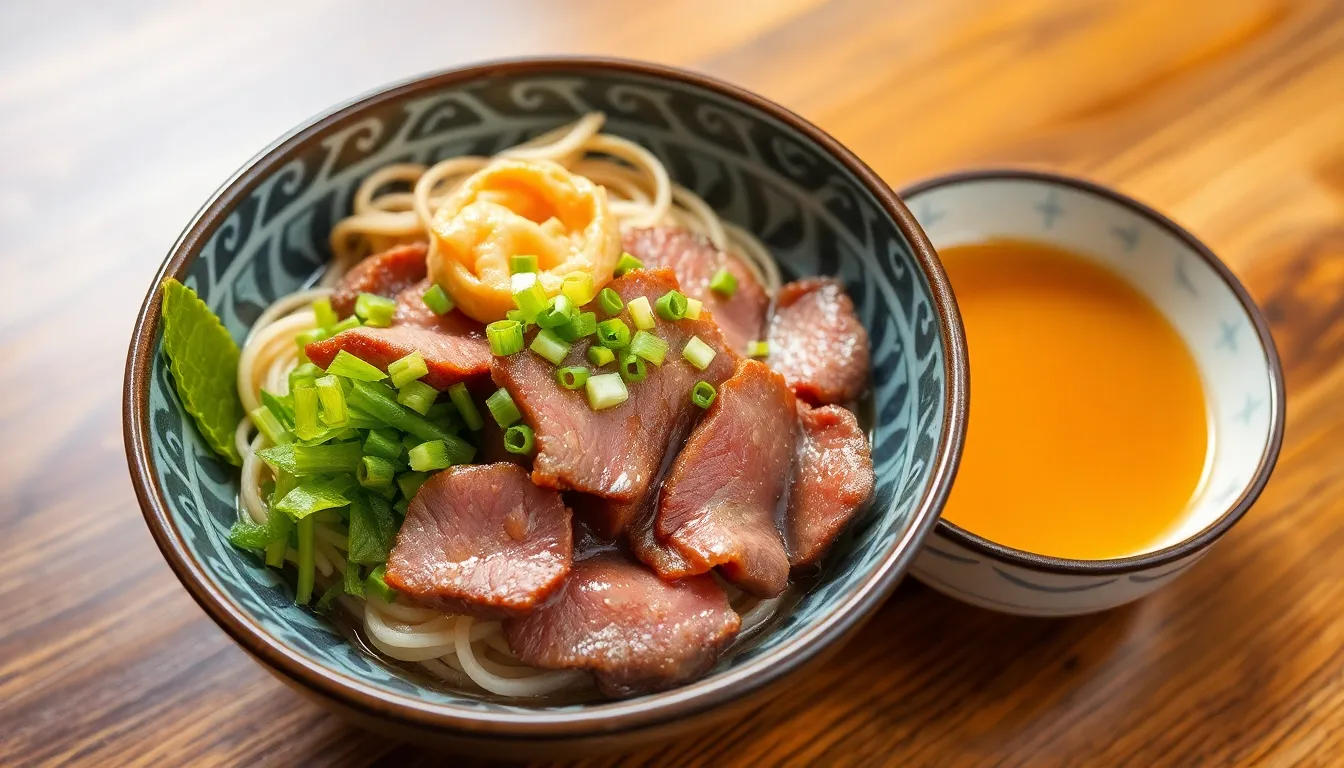
Achieve restaurant-quality gyudon at home with these expert recommendations that elevate your rice cooker version from good to exceptional:
- Select the right beef cut: Opt for thinly sliced chuck or ribeye for optimal tenderness and flavor. The marbling in these cuts creates a richer taste as it melts during cooking.
- Cut onions properly: Slice onions approximately 2cm (0.8 inch) thick to maintain their texture throughout the cooking process rather than having them disappear into the sauce.
- Use fresh ginger: Thinly slice or grate fresh ginger to infuse aromatic qualities without overwhelming the dish. This subtle addition makes a important difference in authentic flavor.
- Choose appropriate rice: Short grain Japanese rice provides the sticky texture that perfectly complements gyudon’s savory components.
- Enhance umami depth: Incorporate kombu or dashi powder into your cooking liquid to create a deeper flavor profile that rivals restaurant versions.
- Allow proper resting time: Let your rice cooker sit for 5 minutes after the cooking cycle completes. This additional steaming time perfects both the rice texture and allows flavors to settle.
- Fluff properly before serving: Gently mix the rice with chopsticks and distribute the beef evenly to ensure each bite contains balanced flavors.
- Garnish thoughtfully: Add traditional toppings like pickled ginger (beni shoga), sliced green onions, shichimi togarashi (Japanese seven spice), or a sprinkle of furikake for authentic presentation and flavor enhancement.
- Balance your meal: Serve your gyudon alongside a simple miso soup for a complete Japanese dining experience that feels both satisfying and authentic.
- Adjust seasonings to taste: Your first attempt may need fine-tuning—feel free to modify the soy sauce, sugar, or sake ratios in subsequent batches to match your preference.
Variations And Substitutions

Protein Options
You can customize your rice cooker gyudon with different protein choices beyond the traditional beef. Thinly sliced pork (butadon) works excellently as a more affordable alternative while maintaining the dish’s essence. Chicken thighs cut into thin strips offer a lighter variation that still absorbs the savory-sweet flavors beautifully. For a vegetarian version, try using sliced portobello mushrooms or firm tofu, which provide satisfying texture and absorb the umami-rich sauce. Regardless of your protein choice, maintain the thin slicing technique to ensure proper cooking in the rice cooker environment.
Seasoning Adjustments
The flavor profile of gyudon can be adapted to suit your taste preferences or pantry availability. Kombu can be replaced with 1/4 teaspoon MSG or 1 teaspoon dashi powder to enhance the umami foundation. For a sweeter profile, increase the mirin proportion or add 1-2 tablespoons of honey instead of sugar. Those preferring a more savory dish might reduce the sugar and increase soy sauce by 1 tablespoon. Brown sugar can substitute white sugar for a deeper molasses note. If sake is unavailable, dry white wine or even water with a splash of rice vinegar provides adequate substitution while maintaining the dish’s balance.
Vegetable Variations
Onions form the traditional base for gyudon, but several vegetables can enhance or replace them. Thinly sliced bell peppers add color and sweetness when added with the onions. Shiitake or enoki mushrooms introduce earthy complexity when scattered atop the beef layer. Thinly sliced carrots provide natural sweetness and vibrant color, while baby spinach can be stirred in immediately after cooking for a nutritional boost. Fresh bean sprouts added during the final minutes of cooking contribute delightful texture contrast to the tender beef and soft rice.
Rice Alternatives
While short-grain Japanese rice creates the authentic gyudon experience, other grains can produce interesting variations. Brown rice offers nutritional benefits but requires adjusted cooking liquid and time according to your rice cooker specifications. A 50/50 blend of white and brown rice creates a balanced middle ground with added fiber. Quinoa or barley can substitute partially or entirely for rice, though cooking ratios will need adjustment—typically increasing liquid by 1/4 cup. For low-carb adaptations, cauliflower rice works surprisingly well when added only during the final 5 minutes of cooking.
Regional Inspirations
Gyudon recipes vary across Japan, offering inspiration for your rice cooker version. Kansai-style gyudon features a lighter, more subtly flavored broth than the Tokyo version. Hokkaido preparations often incorporate butter and corn for regional character. For a Korean-inspired twist, add 1 tablespoon of gochujang (fermented chili paste) and 1 teaspoon of toasted sesame oil to the sauce mixture. Chinese-influenced variations might include five-spice powder (1/4 teaspoon) and a splash of oyster sauce for complex depth. These regional adaptations maintain the dish’s soul while expanding its flavor horizon.
Serving Suggestions
Traditional gyudon garnishes can be customized to create distinctive serving experiences. A raw egg yolk centered atop the hot dish creates a luxurious sauce when stirred in. Onsen tamago (soft-cooked egg) offers similar richness with less concern about raw consumption. Kimchi provides tangy spice that cuts through the sweetness of the traditional sauce. Avocado slices introduce creamy texture that complements the savory beef beautifully. Furikake (Japanese seasoning blend) sprinkled over the finished dish adds umami complexity and visual appeal to your rice cooker creation.
Serving Suggestions

After your rice cooker has worked its magic, it’s time to present your gyudon in a way that honors this beloved Japanese comfort food. Serve your beef bowl piping hot in individual bowls, with the savory beef and onion mixture ladled generously over a bed of fluffy Japanese short-grain rice. The sticky texture of proper Japanese rice creates the perfect foundation for catching all the flavorful sauce.
Elevate your rice cooker gyudon with traditional garnishes that add color, texture, and flavor complexity:
- Sprinkle freshly chopped green onions across the top for brightness and a mild onion flavor
- Add a small pile of beni shoga (pickled ginger) on the side for tangy contrast
- Dust with shichimi togarashi (Japanese seven-spice blend) for a gentle heat
- Scatter toasted sesame seeds over the beef for nutty depth
Complete your meal by serving gyudon alongside a simple bowl of miso soup for an authentic Japanese dining experience. This classic pairing creates balance, with the savory soup complementing the sweet-savory flavors of the beef bowl.
For a restaurant-style presentation, consider topping your gyudon with a raw egg yolk in the center, which creates a luxurious sauce when mixed into the hot rice and beef. This addition transforms your homemade dish into something truly special with minimal effort.
Store any leftover gyudon in airtight containers in the refrigerator for 2-3 days. The flavors often develop overnight, making next-day gyudon particularly delicious when gently reheated in the microwave or in a small pan with a splash of water.
Storing And Reheating Leftovers
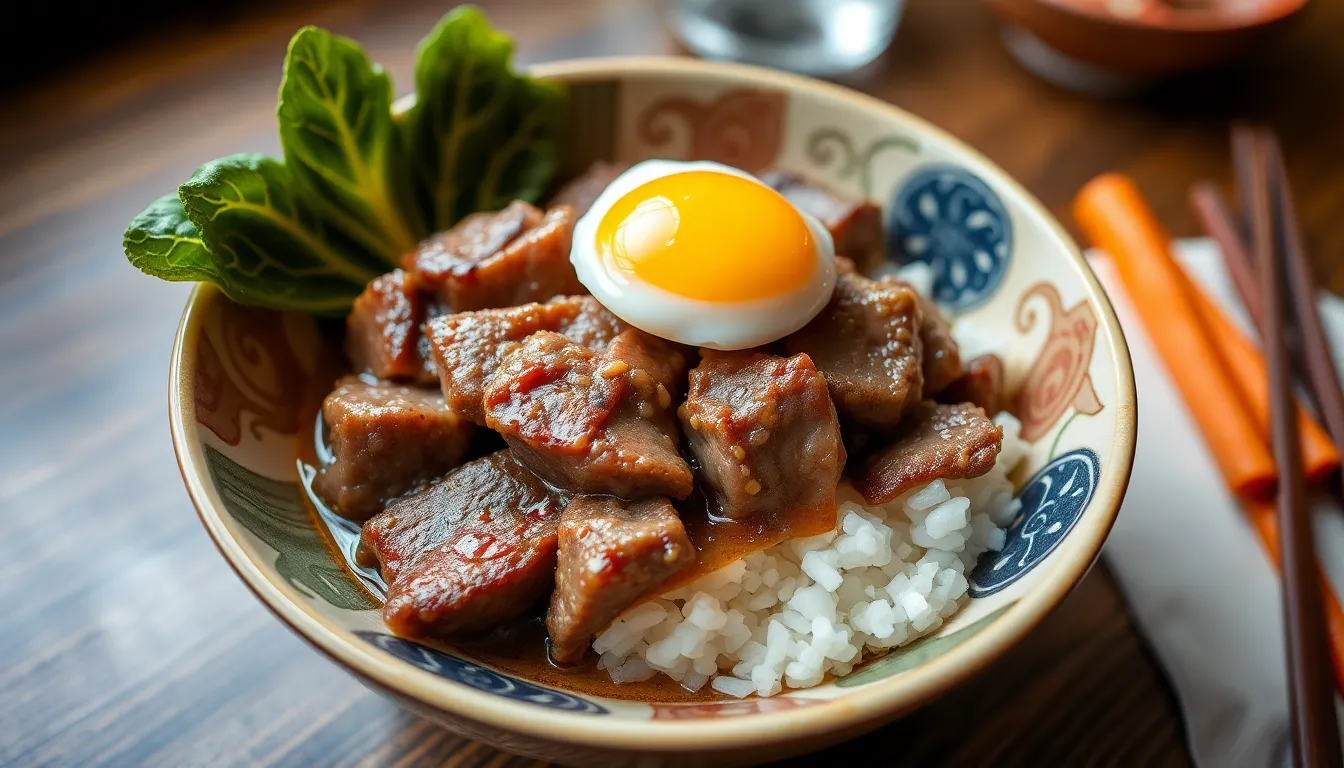
One of the best aspects of rice cooker gyudon is how well it keeps as leftovers. Properly stored gyudon maintains its delicious flavor profile and can even develop deeper taste notes over time. To preserve your leftover gyudon at peak quality follow these storage guidelines:
- Store cooled gyudon in airtight containers within 2 hours of cooking
- Refrigerate leftovers for 2-4 days for optimal freshness
- Freeze portions in freezer-safe containers for up to 2-3 months
- Keep rice and beef mixture together for convenience
- Label containers with the date to track freshness
When you’re ready to enjoy your leftover gyudon the reheating process is straightforward. Transfer your desired portion to a microwave-safe dish and heat thoroughly until the internal temperature reaches at least 165°F. For best results add a tablespoon of water before reheating to prevent the rice from drying out.
Pro tip: Save the egg component for fresh preparation. Rather than storing cooked eggs with your leftovers prepare fresh eggs when reheating your gyudon. A freshly added raw egg yolk or quick-fried egg on top of reheated gyudon creates that restaurant-quality experience even with day-old leftovers.
The flavor of gyudon often improves after a day in the refrigerator as the sauce further permeates the beef and rice. This makes gyudon an excellent meal prep option for busy weekdays when you need quick satisfying meals with minimal effort.
For variety with your leftovers consider adding fresh vegetables when reheating. Mushrooms carrots spinach kale or bok choy can transform yesterday’s gyudon into an entirely new meal experience. Just sauté your vegetables separately and add them to your reheated gyudon for added nutrition and textural contrast.
The Perfect One-Pot Meal For Busy Weeknights
Rice cooker gyudon revolutionizes how you’ll approach Japanese comfort food at home. This ingenious one-pot method transforms a traditionally complex dish into an accessible weeknight staple without sacrificing authentic flavor.
You’ll appreciate how this technique saves precious time while delivering restaurant-quality results. The layered cooking approach ensures every grain of rice absorbs the savory-sweet essence of the beef topping.
Whether you’re a college student with minimal kitchen space or a busy professional seeking efficient meal answers you’ll find rice cooker gyudon to be the perfect addition to your culinary repertoire. With endless opportunities for customization and simple storage options it’s a versatile dish that fits seamlessly into your lifestyle.
Give your rice cooker new purpose and discover the joy of effortless Japanese cooking right in your own kitchen.
Frequently Asked Questions
What is gyudon?
Gyudon is a popular Japanese dish consisting of thinly sliced beef and onions simmered in a savory-sweet sauce, served over a bowl of rice. The name comes from “gyu” (beef) and “don” (rice bowl). It originated during the Meiji era and has become a staple in Japanese cuisine, available at restaurant chains like Yoshinoya and Sukiya.
Why use a rice cooker to make gyudon?
Using a rice cooker for gyudon simplifies the cooking process by creating a one-pot meal. This method eliminates the need to cook components separately, saves time, reduces cleanup, and enhances flavor as the savory sauce infuses the rice during cooking. The rice cooker provides consistent results with minimal monitoring, making it ideal for beginners and busy weeknights.
What type of beef works best for gyudon?
Thinly sliced beef chuck or ribeye works best for authentic gyudon. The meat should be sliced paper-thin (about 2mm) to ensure quick cooking and tender texture. Pre-sliced “shabu shabu” or “sukiyaki” beef from Asian markets is ideal, but you can also ask your butcher to thinly slice beef or partially freeze it at home to make slicing easier.
Can I make vegetarian gyudon?
Yes, you can make vegetarian gyudon by substituting the beef with portobello mushrooms, firm tofu, or plant-based meat alternatives. Slice the mushrooms thinly and use the same cooking method. You’ll need to replace the dashi with vegetable stock or kombu dashi, and you may want to add extra umami flavor with soy sauce or mushroom powder.
What are the essential ingredients for rice cooker gyudon?
The essential ingredients include: short-grain Japanese rice, thinly sliced beef, onions, fresh ginger, soy sauce, mirin, sake, sugar, and dashi granules or kombu. For garnishing, green onions, pickled ginger, and shichimi togarashi (Japanese seven-spice blend) are commonly used. All ingredients can typically be found at Asian grocery stores or in the international aisle of supermarkets.
How long does it take to cook gyudon in a rice cooker?
Cooking gyudon in a rice cooker takes about 30-40 minutes total, depending on your rice cooker model. This includes about 10 minutes of preparation time for rinsing rice and slicing ingredients, and 20-30 minutes of cooking time on the regular rice setting. After cooking, allow the dish to rest for 5-10 minutes before serving.
Can I make gyudon ahead of time?
Yes, gyudon is excellent for meal prep. Once cooked, it can be refrigerated for 2-4 days in airtight containers. The flavor often improves after sitting overnight. For longer storage, freeze portions in airtight containers for up to 2-3 months. When reheating, add a tablespoon of water to prevent the rice from drying out.
What can I serve with gyudon?
Traditional accompaniments include miso soup, pickled vegetables like fukujinzuke or gari (pickled ginger), and a simple side salad with wafu (Japanese) dressing. For a more authentic experience, serve with a raw egg yolk on top (if using pasteurized eggs) or a soft-boiled egg. Steamed vegetables or tsukemono (Japanese pickles) also make excellent sides.
How do I achieve the perfect rice texture?
For perfect rice texture, rinse the short-grain Japanese rice 3-4 times until the water runs clear, removing excess starch. Let the rinsed rice drain for 15-30 minutes before cooking. Use the correct water-to-rice ratio according to your rice cooker instructions (typically 1:1 for Japanese rice). After cooking, let the rice rest for 10 minutes before fluffing gently.
Can I adjust the sweetness of the gyudon sauce?
Absolutely! The traditional gyudon sauce balances sweet and savory flavors, but you can adjust to your preference. For less sweetness, reduce the amount of sugar and mirin. For a sweeter profile, increase these ingredients slightly. You can also add a dash of dashi or soy sauce for more umami flavor or a splash of sake for depth.
